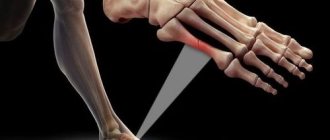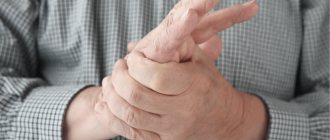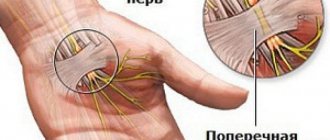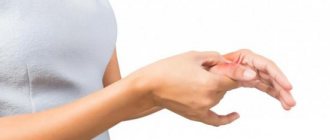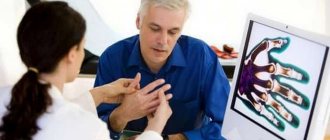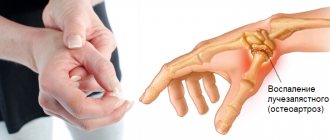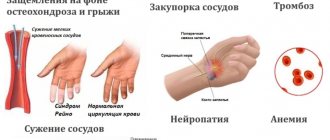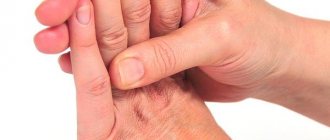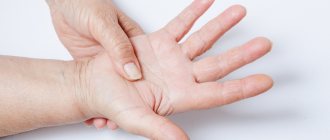A knocked-out finger is a closed tissue injury, with a displacement of the phalanges of the fingers relative to each other and a violation of the articular articulation. Often accompanied by rupture of ligaments, rupture of the joint capsule, and bone fractures.
Most often, the thumb, index, and ring fingers are knocked out; little finger and big toe. Boxers and other martial arts athletes often knock out the so-called “kazanok” (metacarpophalangeal joint) on the little finger and ring finger.
Author of the article / Site experts Shulepin Ivan Vladimirovich, traumatologist-orthopedist, highest qualification category
Total work experience over 25 years. In 1994 he graduated from the Moscow Institute of Medical and Social Rehabilitation, in 1997 he completed a residency in the specialty “Traumatology and Orthopedics” at the Central Research Institute of Traumatology and Orthopedics named after. N.N. Prifova.
What is a dislocated finger?
The hand is one of the most vulnerable parts of the musculoskeletal system in terms of injury. Each of the five fingers is three joints, or two if we are talking about the thumb, and each of the joints is at risk of dislocation in the event of not even too strong, but simply an unfortunate mechanical impact.
As a rule, a dislocated finger consists of the fact that the finger or one or two of its phalanges are displaced relative to each other, and the articulation of the articular surfaces is disrupted. The joint loses its functionality, the damage is accompanied by quite acute pain, which is also due to the high concentration of nerve endings on the fingers.
A dislocated finger joint may be accompanied by a pinched or ruptured tendon, as well as a rupture of the joint capsule, which can significantly complicate the situation.
1.General information
Surgery today is known to work miracles. However, the best of surgeons have always been distinguished by this, but modern surgery, armed with the principles of antiseptics, high technology and wise recommendations of the WHO, often actually demonstrates amazing operations that were completely impossible until recently.
Traumatic amputation of fingers and limbs has been a pressing problem for medicine since its inception (given the restless nature of humanity as a patient). It has not been possible to sew back something that has been torn off, bitten off, cut off, or chopped off for thousands of years, since such restoration requires clear ideas about what infection and necrosis are, what blood vessels and nerves are, what immunity is, and what the regenerative capabilities of a particular other fabric. In addition, it is advisable to have a good operating microscope. But today we have come close to the issue of head transplantation, and this issue is being discussed not in a science-fiction manner, but in a calm technological and methodological manner, as always happened before the development and implementation of any new technique in everyday practice.
As for the return of severed fingers to their original position, this will not surprise anyone for a long time: even schoolchildren know what to do and where to run in such a situation. Meanwhile, this microsurgical operation, and even with the task of at least partial restoration of motor function, is only slightly less “fantastic” in essence and complexity. Paradoxically, replanting an entire hand is easier than replanting one finger, and a toe is easier than replanting part of a foot. However, it is generally inappropriate to talk about any “simplicity” here.
The history of such operations goes back only a little more than half a century, but today finger replantations are performed all over the world, techniques continue to be improved, and the proportion of successful engraftments ranges (according to various data and depending on a number of indicators) from 65% to 90%.
A must read! Help with treatment and hospitalization!
The main reasons leading to finger dislocations
The causes of dislocated fingers are mainly traumatic. Falling with emphasis on the hand, unsuccessfully hitting the ball or awkward movement on sports equipment, trying to lift too much weight and it slipping, contact sports become the most common causes of such an injury. In addition, it is necessary to take into account the possible predisposition that can be caused by deforming diseases of the joints, previous injuries, even the habit of clicking the joints, pulling or pressing the fingers.
2. Reasons
Traumatic amputation of a finger today can occur for a variety of reasons: combat, terrorist attacks, transport accidents and industrial accidents. Among purely peaceful everyday causes, the leading cause is careless handling or (much less often) breakdown of various mechanisms and tools, especially high-speed electromechanical equipment. However, sometimes partial or even complete amputation of the finger phalanges also happens in an ordinary kitchen - if the household has well-sharpened cutting knives and hatchets.
Of course, the most dramatic (and difficult from a surgical and rehabilitation point of view) situation is created when fingers are damaged in children - as a result of pranks or a simple misunderstanding of the possible consequences. All responsibility here, in fact, lies with adults: cutting, stabbing, chopping, rotating objects should be completely inaccessible to a small child, and explained to older children and absolutely understandable in terms of purpose, mechanism of action and especially safety precautions.
Visit our Microsurgery page
First aid for a dislocated finger
- If there are rings on the knocked-out finger, or at least on this hand, you should try to carefully remove them as quickly as possible. Dislocation very often leads to swelling, in which any compression is dangerous.
- Apply ice and try to keep your hand elevated. This will help reduce swelling, one of the most unpleasant consequences of a sprain. The more successfully you manage to prevent swelling in the first minutes and hours, the faster the hand will restore its functionality.
- If it is possible to press the healthy finger against the damaged one, it is useful to apply a bandage that secures them together.
- If the pain is severe, you can take an analgesic.
- It is imperative to seek medical help - to a traumatologist or surgeon, where a diagnosis will be made to rule out other injuries, the finger will be professionally reset, and treatment will be prescribed.
Symptoms of injury
A person who has received such an injury faces, first of all, obvious deformation of the metacarpophalangeal joint
and almost complete inability to move this part of the hand. During passive movements, the thumb springs elastically.
In addition to these visually detectable abnormalities, the victim complains of severe pain in the damaged area. The joint usually greatly increases in size, and the skin may be hotter and swollen than the surrounding tissue.
How is a broken finger diagnosed?
Despite the apparent obviousness, only a qualified medical professional can confidently diagnose a dislocated finger joint, and he also makes decisions about treatment. This is due to the fact that swelling and severe pain can accompany not only a dislocation, but also cracks and fractures of bones. And in this case, completely different help will be required.
To rule out a fracture, the doctor may order an x-ray, but often gets by with a routine examination and questioning of the patient.
There are also fracture-dislocations. This is a more severe injury and requires exclusively surgical treatment, otherwise the damaged joint will subsequently be functionally limited, and constant pain may occur. If this injury is ignored, arthrodesis (locking) or joint replacement will eventually be required.
What to do with a knocked out thumb?
How to proceed? Should I go to the doctor or try to feel my finger? Correct diagnosis is key, including differentiating mild subluxation from more severe dislocation. In the first of these cases, the joint capsule is not damaged, and the deformity of the finger is minor and usually temporary. In such a situation, the procedure may be limited to the use of painkillers and the implementation of 5 steps, which in medical and physiotherapeutic practice is called the PRICE principle.
This term is an abbreviation consisting of English words:
- Protection – protection. First, you should immobilize the pinched toe to prevent the injury from getting worse. You need to move to a safe place and tense/cloth your finger.
- Rest - rest. A sprained thumb takes time to heal. Therefore, it is necessary to completely abandon any activity related to the finger for at least 2 days.
- Ice is ice. The injured thumb should be cooled to limit hematoma at the site of injury. Ice cubes, a towel soaked in ice water, or a professional cooling compress are ideal for this.
- Constipation - tightness. Used over the site of injury. This procedure helps reduce swelling.
- Height – elevation. It is recommended to hold the injured arm above the line of the heart; this will slightly lower blood pressure and also relieve swelling.
About
Treatment and rehabilitation for a dislocated finger
The complexity and duration of treatment depends on three factors:
- severity of damage,
- correctly provided first aid to avoid worsening the situation,
- timeliness of seeking medical help.
In any case, the dislocated finger is reduced, if necessary, with local anesthesia, since the procedure can be quite painful.
The hand is fixed in a comfortable position, then the doctor pulls and simultaneously sets the finger.
The reduced finger is fixed with a plaster cast or a special orthosis, ensuring immobility. This will avoid unnecessary pain from accidental displacements and will speed up the normalization of the damaged joint.
After reduction/surgical intervention and application of a bandage, the following may be prescribed to speed up rehabilitation:
- local agents (ointments) with anti-edematous, anti-inflammatory, analgesic effects;
- physiotherapeutic procedures;
- massotherapy;
- a special set of exercises for the injured hand - after the swelling has completely subsided and the pain has stopped.
All this will allow you to completely restore the functions of the hand, restoring its functionality and health, and avoid the future development of “habitual dislocation” or other complications.
Important: seek help in a timely manner. There are often cases when the pain during a dislocation weakens after some time and goes away without help. But the dislocation itself will go away on its own, but realigning the phalanx will be more difficult. Sometimes soft tissues are pinched between the articular surfaces; increased swelling and unoperated ligament ruptures can cause limited movement and subsequently contracture. Sometimes a late-reduced dislocation becomes habitual, that is, recurring due to the fact that the damaged ligaments have not fully recovered.
Treatment of knocked out fingers
Treatment tactics and duration depend on the complexity of the injury.
For minor injuries, if there is no dislocation, fracture or ligament rupture, a tight bandage and a number of procedures that can be carried out independently at home are sufficient.
Ice is applied in the first 2-3 days after the injury. No more than 15-20 minutes several times a day. This helps relieve swelling and pain;
From the 3rd day you can start making warm compresses using absorbable ointments. For example, Fastum-gel, Dolobene, Troxevasin, Diclofenac-gel, Indovazin. At this stage, it is permissible to use folk remedies. Usually these are infusions of chamomile, tansy, celandine, and calendula. The compress is changed 2-3 times a day.
The most basic finger exercises
After the swelling has subsided, you can begin to do light massage and restorative exercises. This will help to quickly return all functions of the finger.
If there is pain, you can take painkillers - analgin, ketanov, pentalgin, etc.
Reduction of dislocated fingers
If the dislocation is complicated by damage to the ligaments or joint capsule, surgery may be required.
As mentioned above, if a dislocation is accompanied by a fracture, surgery is necessary. During surgery, the fracture is fixed with knitting needles or screws or a miniplate.
A distraction device may be required to correct an old dislocation.
| Extensor tendons | To the list of articles | Metacarpal fracture |
Bandage for a broken thumb
If the injury is more severe, your orthopedic surgeon will recommend a longer toe support. A perforated thumb cast may be made of plaster, or the patient may be able to use a more flexible orthosis. The standard fixation time in this case is approximately 3 weeks.
The purpose of the bandage is not only to protect the weakened joint structures, but also to give them time to recover while being completely immobilized. Short-term rehabilitation is usually required after the cast or orthosis is removed.
During this time, you can also undergo the following procedures:
- cryotherapy (cold treatment),
- hydrotherapy (hydrotherapy),
- laser therapy (light therapy).
About
Complications and consequences
An untreated knocked out finger may lose functionality. Finger bruises with trauma to bone structures and tendon rupture can have serious consequences. Hand injuries should not be neglected, despite their apparent ease. Chronic inflammation of the joints can cause decreased hand performance and a deterioration in quality of life.
Dear readers of the 1MedHelp website, if you still have questions on this topic, we will be happy to answer them. Leave your reviews, comments, share stories of how you experienced a similar trauma and successfully dealt with the consequences! Your life experience may be useful to other readers.
Let's draw a conclusion
When your finger is swollen and you are not sure whether it is a sprain or not, immediately put ice on it to relieve the swelling and go to the hospital to see a traumatologist. You will be examined, if necessary, they will send you to take an x-ray, and will provide qualified assistance and further treatment. You should not straighten the phalanges yourself; you can significantly aggravate an already unpleasant situation.
Friends, we have looked at various situations with dislocated fingers, strengthen your limbs, do not get injured, if this happens, I hope my article will help you not to get confused and take the right steps to provide first aid.
Rehabilitation
The healing process of knocked out fingers does not take much time, but after removing the fixing bandage, the injured hand should be loaded gradually. Exercise therapy, massage, and hardware physiotherapy will help restore a damaged organ. Arm training is carried out with increasing load. First, they perform rotations with the hand, making attempts to clench their hand into a fist without excessive effort. Then the load level is increased. It is useful to sort through small objects, squeeze a tennis ball or rubber ring.
As for physiotherapy, the following procedures will be beneficial:
- applications with paraffin or ozokerite - the warming effect will ensure intensive blood circulation, improve nutrition of damaged tissues and prevent inflammatory processes;
- electrophoresis with nicotinic acid - dilates blood vessels, activates blood circulation, improves repair;
- infrared irradiation – characterized by a biostimulating effect, relieves inflammation, accelerates regeneration.
Diagnostics
If the hand is injured, a consultation with a traumatologist with minimal diagnostics is sufficient. A knocked-out finger with deformity in the joint is clearly visible on an x-ray. It is recommended to do it when a fracture or dislocation is suspected. How can you tell if your bones are damaged? Crunching, clicking and crackling when bending are signs of intra-articular or bone disorders. After an x-ray, doubts about the nature of the injury disappear.
Additional diagnosis of a knocked out finger is necessary when there is a soft tissue rupture. In this case, an MRI will help. Tomography allows you to determine the condition of the interphalangeal ligaments and concomitant articular diseases. Based on the diagnosis received, the doctor makes prescriptions and selects drug therapy.

